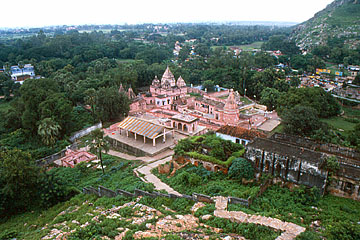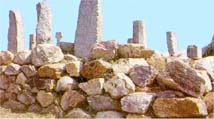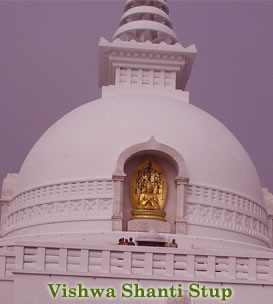|
|
| Rajgir |
|
 Rajgir just 15 kms from Nalanda is located the complex of temples and monasteries. The place is called Rajgir. It is one of the most important tourist places in India. Being located in a valley, Rajgir is a very scenic place. The small hill grit town is covered with lush green forest which add to the beauty of the place. Rajgir was the capital of the Magadh Mahajanpad (State) when Patliputra was not formed. In those days it was called Rajgrih. Rajgir or Rajgrih means the home of Royalty. This place has been associated with Lord Buddha and Buddhism. Buddha not only spent many years in Rajgir but also delivered sermons here and proselytized emperor Bimbisar at the Griddhakoota hill. The Jivekarmavan monastery was the favorite residence for Buddha. Even Bimbisar gave Venuvan Vihar to Buddha for his residence. It is said that it was at Rajgir that physician treated Buddha, Jivak after he was injured by his cousin Devdatta.The teachings of Buddha was penned down at Rajgir and it was also the venue for the first Buddhist Council. Today Rajgir has come up as one of the most important pilgrimage for the Buddhist.Rajgir also has some very beautiful Hindu and Jain temples which attracts Hindus and Jains also to the place. Not only as a place for worship, Rajgir has come up as health and winter resort with its warm water ponds. These ponds are said to contain some medicinal properties which help in the cure of many skin diseases. The added attraction of Rajgir is the Ropeway which takes you uphill to the Shanti Stupa and Monasteries built by the Japanese Devotees on top of the Ratnagiri hills. Rajgir just 15 kms from Nalanda is located the complex of temples and monasteries. The place is called Rajgir. It is one of the most important tourist places in India. Being located in a valley, Rajgir is a very scenic place. The small hill grit town is covered with lush green forest which add to the beauty of the place. Rajgir was the capital of the Magadh Mahajanpad (State) when Patliputra was not formed. In those days it was called Rajgrih. Rajgir or Rajgrih means the home of Royalty. This place has been associated with Lord Buddha and Buddhism. Buddha not only spent many years in Rajgir but also delivered sermons here and proselytized emperor Bimbisar at the Griddhakoota hill. The Jivekarmavan monastery was the favorite residence for Buddha. Even Bimbisar gave Venuvan Vihar to Buddha for his residence. It is said that it was at Rajgir that physician treated Buddha, Jivak after he was injured by his cousin Devdatta.The teachings of Buddha was penned down at Rajgir and it was also the venue for the first Buddhist Council. Today Rajgir has come up as one of the most important pilgrimage for the Buddhist.Rajgir also has some very beautiful Hindu and Jain temples which attracts Hindus and Jains also to the place. Not only as a place for worship, Rajgir has come up as health and winter resort with its warm water ponds. These ponds are said to contain some medicinal properties which help in the cure of many skin diseases. The added attraction of Rajgir is the Ropeway which takes you uphill to the Shanti Stupa and Monasteries built by the Japanese Devotees on top of the Ratnagiri hills.
Site related to Buddha :
 Ajatshatru Fort : Built by Ajatshatru (6th century B.C.), the king of Magadha during the Buddha's time. The 6.5 sq.meter Ajatshatru's Stupa is also believed to have been built by him. Ajatshatru Fort : Built by Ajatshatru (6th century B.C.), the king of Magadha during the Buddha's time. The 6.5 sq.meter Ajatshatru's Stupa is also believed to have been built by him.
Cyclopean Wall : Once 40 Km long, it encircled ancient Rajgir. Built of massive undressed stone carefully fitted together, the wall is one of the few important Pre-Maurayan stone structures ever to have been found. Traces of wall still subsist, particularly at the exit of Rajgir to Gaya.
 Shanti Stupa : The Vishwa Shanti Stup is located on a 400 meter high hill. The stupa is built in marble and on the four corners of the stupa are four glimmering statues of Buddha. To reach the top of this hill one has to come through the “Ropeways”. This place is also called the GriddhKoot. Shanti Stupa : The Vishwa Shanti Stup is located on a 400 meter high hill. The stupa is built in marble and on the four corners of the stupa are four glimmering statues of Buddha. To reach the top of this hill one has to come through the “Ropeways”. This place is also called the GriddhKoot.
Venu Vana: Site of the monastery Venuvana Vihar built by king Bimbisara for Lord Buddha to reside. This was the king's first offering to Lord Buddha.
Karanda Tank : It is the tank in which Buddha used to bathe.
Sonbhandar Caves: Two rather strange cave chambers were hollowed out of a single massive rock. One of the chambers I believed to have been the guard room, the rear wall has two straight vertical lines and one horizontal line cut into the rock; the doorway is supposed to lead to king Bimbisara Treasury. Inscriptions in the Sankhlipi or shell script, etched into wall and so far undeciphered, are believed to give the clue to open the doorway. The treasure, according to folklore, is still intact. The second chambers bears a few traces of seated and standing etched into the outer wall.
Bimbisar jail : his impatient saon and heir, Ajatashatru, imprisoned King Bimbisara here. The captive king chose this site for his incarceration, for, from this spot he could see Lord Buddha climbing up to his mountain retreat atop the Griddhakuta hill. There is a clear view of the Japanese Pagoda. The stupa of peace was built on the top of the hill.
Veerayatan: A Jain Temple and Museum.
Hot Springs : At the foot of Vaibhava Hill, a staircase leads up to the various temples. Separate bathing places have been organized for men and women and the water comes through spouts from Saptdhara, the seven streams, believed to find their source behind the "Saptarni Caves", up in the hills. The hottest of the springs is the Brahmakund with a temperature of 45 degree Centigrade.
Gridhakuta : This was the place where the lord Buddha set in a motion his second wheel of law an for three months even during the rainy season, preached many inspiring sermons to his disciples. The Buddha Sangha of Japan have constructed a massive modern stupa, the Shanti Stupa (Peace Pagoda), at the top of the hill in commemoration. A bridle path leads to up to the hill but it is much more fun to take the Aerial Chair lift which operates every day except Thursday. One way ride takes 7.5 minutes and the view is splendid over the hills of Rajgir. |
How to Reach Rajgir
General Information
Temperature (Max./Min.) Deg C : Max. 40/Min. 20 Winter-Max. 28 Min. 6 Rainfall :186 cms (Mid-June to Mid-September) Best Season : October to March.
How to Reach
Air : The nearest airport is at Patna 101 kms. Indian Airlines connect Patna to Calcutta, Bombay, Delhi, Ranchi and Lucknow.
Rail : Though Rajgir itself has a railway station yet the nearest convenient railhead is at Gaya 78 kms.
Road : Rajgir is connected by road to Patna - 110 kms, Nalanda - 12 kms, Gaya - 78 kms, Pawapuri - 38 kms, Bihar Sharif - 25 kms etc. Bus : Regular buses are available from all the above said points to Rajgir.
Local Transport : Taxis and Buses and Tongas are available.
Where to Stay
There are a number of moderately priced hotels in the town. Tourist can stay at any of three Tourist Bungalows maintained by the Bihar State Tourism Development Corporation.
Tourist Bungalows :
Ajatshatru Vihar
Phone: 06119-255027.
Facility Available: Restaurant, CTV, Conference Hall, Coach/Car Parking.
Rooms available: Dormitory Beds available only.
Gautam Vihar
Phone: 06119-255273.
Facility Available: Restaurant, Conference Hall, Laundry, Car Parking.
Rooms available: AC Room, Deluxe Room and Dormitory Beds.
Tathagat Vihar
Phone: 06119-255176.
Facility Available: Restaurant, CTV, Conference Hall, Coach/Car Parking.
Rooms available: AC Room,Deluxe Room and Economy Room.
Back To BuddhaBihar Mennu Page

|
|
|